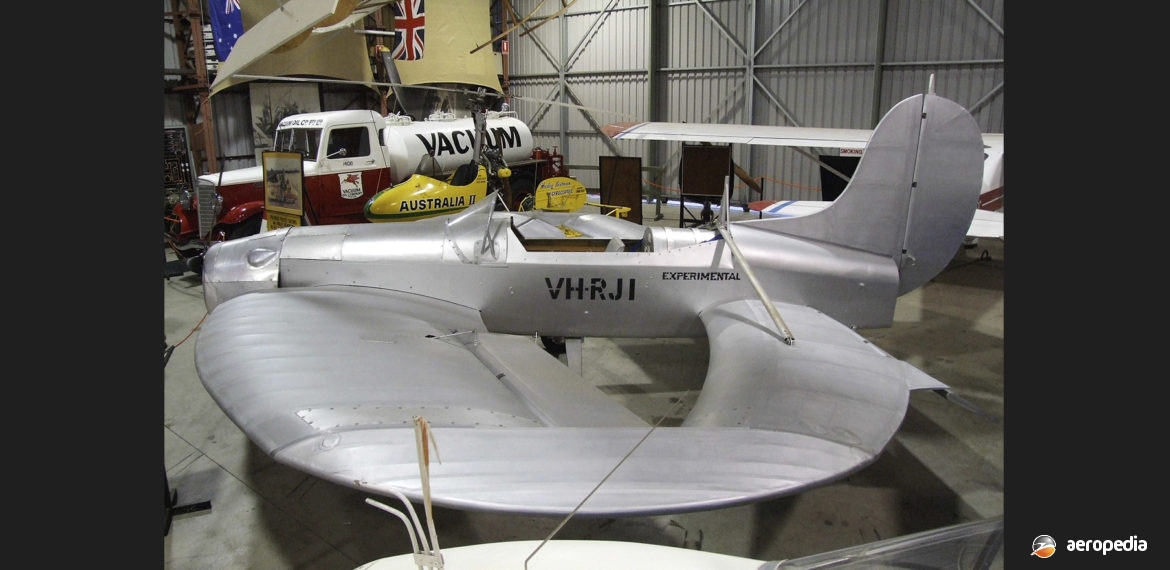Photograph:
Feast Circle prototype VH-RJI (c/n R090) on display at the Australian Aviation Museum at Bankstown, NSW (David C Eyre)
Country of origin:
Australia
Description:
Light experimental aircraft
Power Plant:
One 60 kw (80 hp) Rotax 912 four-cylinder, four-stroke, liquid-and-air-cooled engine
Specifications:
- Wingspan: 7 m (23 ft)
- Length: 6.4 m (21 ft)
History:
The Circle was a radical design built in Sydney by Ronald J Feast. Mr Feast spent many years designing and building model aircraft and in later years worked on models of a circular-wing aircraft. A series of eight radio-controlled models of the aircraft was built and all were flown successfully as ‘proof of concept’ aircraft. Built in four parts, the wing was not exactly circular as it was considered this would make the aircraft too long, and it ended up being slightly oval in shape.
Power was provided by a 60 kw (80 hp) Rotax 912 four-cylinder four-stroke engine. It was originally built as a two-seater but, due to centre of gravity requirements, the rear seat compartment was re-designed to hold the fuel tank.
Construction commenced in October 1997 and was completed over a period of 3½ years. Each of the wings, main front and rear, were constructed in one length and had curved spars, being covered with Ceconite, but the leading-edges of the main wings were plywood covered.
A number of taxi and short hop trials were completed successfully by Graham White at Camden, NSW in July 2001 and continued until December 2001 when it was decided to make a number of design changes to improve lateral control at slow speeds. These entailed the rear main wing being moved forward to obtain a more compact external shape, and new shortened side wings were constructed. Both main wings were cut at the centre and joined internally in the fuselage to achieve a 5 degrees dihedral.
The tricycle undercarriage had hardened aluminium leaf springs, with coil expansion springs and cables. The nosewheel had a castering action and the ailerons and elevators received streamlined leading-edges and increased area. The re-designed aircraft was completed in November 2004 and taxiing tests commenced in February 2005. On 23 August that year the aircraft received its registration VH-RJI (c/n R090).
The designer of the aircraft claimed the advantages of the design to be: a large wing area in a small space; light structural weight; automatic stability, crew protection, very low landing speeds, and a much gentler stall than conventional wings. As noted elsewhere, Melbourne designer Karl Dehn built a similar design which flew in October 1985 known as the Dehn Ring Wing, it being 4.4 m (14 ft 4 in) in diameter and constructed mainly of fibreglass.
The Feast Circle was built of timber, the fuselage being basic Jodel D-18, the wood used being Hoop Pine from Queensland and GL1 plywood from Finland. The fin and rudder were basic Jodel type construction. The box spars had laminated booms, these and the main wings being built of timber.
After trials and evaluation the designer hoped to design and build a high-speed plane with a short wing span, the wings to be of pure cantilever construction with no cable bracing. It would seat two in an enclosed cabin, have carbon fibre wings spars with ply ribs and ply covering and be fitted with a 134 kw (180 hp) Continental engine. Performance would include speeds in the 463 km/h (288 mph) region. In July 2005 VH-RJI was dismantled and placed in storage at Camden, later being gifted to the Australian Aviation Museum at Bankstown, NSW and placed on display. In 2019, following the closure of the Bankstown museum in 2018, with a number of other aircraft, it was exported to a museum at Wanaka in New Zealand.

